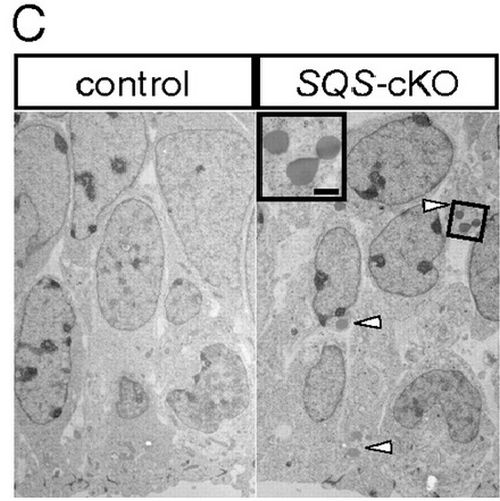Ablation of cholesterol biosynthesis in neural stem cells increases their VEGF expression and angiogenesis but causes neuron apoptosis.
Although sufficient cholesterol supply is known to be crucial for neurons in the developing mammalian brain, the cholesterol requirement of neural stem and progenitor cells in the embryonic central nervous system has not been addressed. Here we have conditionally ablated the activity of squalene synthase (SQS), a key enzyme for endogenous cholesterol production, in the neural stem and progenitor cells of the ventricular zone (VZ) of the embryonic mouse brain. Mutant embryos exhibited a reduced brain size due to the atrophy of the neuronal layers, and died at birth. Analyses of the E11.5-E15.5 dorsal telencephalon and diencephalon revealed that this atrophy was due to massive apoptosis of newborn neurons, implying that this progeny of the SQS-ablated neural stem and progenitor cells was dependent on endogenous cholesterol biosynthesis for survival. Interestingly, the neural stem and progenitor cells of the VZ, the primary target of SQS inactivation, did not undergo significant apoptosis. Instead, vascular endothelial growth factor (VEGF) expression in these cells was strongly upregulated via a hypoxia-inducible factor-1-independent pathway, and angiogenesis in the VZ was increased. Consistent with an increased supply of lipoproteins to these cells, the level of lipid droplets containing triacylglycerides with unsaturated fatty acyl chains was found to be elevated. Our study establishes a direct link between intracellular cholesterol levels, VEGF expression, and angiogenesis. Moreover, our data reveal a hitherto unknown compensatory process by which the neural stem and progenitor cells of the developing mammalian brain evade the detrimental consequences of impaired endogenous cholesterol biosynthesis.

- Proc. Natl. Acad. Sci. U.S.A. 2009 May 19;106(20):8350-5
- 2009
- Neurobiology
- 19416849
- PubMed
Enabled by:
